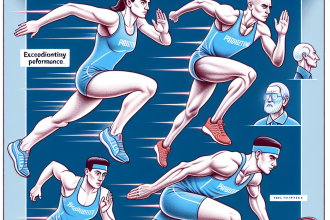-
Table of Contents
Aquous Testosterone Suspension in the World of Sports: A Critical Review
The use of performance-enhancing drugs in sports has been a controversial topic for decades. Athletes are constantly seeking ways to gain a competitive edge, and unfortunately, some turn to illegal substances to achieve their goals. One such substance that has gained attention in recent years is aquous testosterone suspension. This article will provide a critical review of this substance and its use in the world of sports.
What is Aquous Testosterone Suspension?
Aquous testosterone suspension, also known as testosterone suspension, is a synthetic form of the male hormone testosterone. It is typically administered through injection and is used to increase muscle mass, strength, and athletic performance. This substance is classified as an anabolic steroid, which means it mimics the effects of testosterone in the body.
Testosterone suspension was first developed in the 1930s and was used medically to treat conditions such as delayed puberty and muscle wasting diseases. However, it was soon discovered that this substance had significant performance-enhancing effects, leading to its widespread use in the world of sports.
Pharmacokinetics and Pharmacodynamics
Pharmacokinetics refers to how a substance is absorbed, distributed, metabolized, and eliminated by the body. In the case of testosterone suspension, it is rapidly absorbed into the bloodstream after injection and has a half-life of approximately 2-4 hours (Kicman, 2008). This means that it is quickly metabolized and eliminated from the body.
Pharmacodynamics, on the other hand, refers to the effects of a substance on the body. Testosterone suspension works by binding to androgen receptors in the body, which then stimulates protein synthesis and muscle growth (Kicman, 2008). It also has an anti-catabolic effect, meaning it can prevent muscle breakdown during intense exercise.
Effects on Athletic Performance
The use of testosterone suspension in sports is primarily to enhance athletic performance. Studies have shown that it can increase muscle mass, strength, and power (Kicman, 2008). This can be beneficial for athletes in sports that require explosive movements, such as sprinting and weightlifting.
Additionally, testosterone suspension has been shown to improve recovery time between workouts, allowing athletes to train more frequently and intensely (Kicman, 2008). This can lead to faster gains in muscle mass and strength.
Side Effects and Risks
While testosterone suspension may have performance-enhancing effects, it also comes with a range of potential side effects and risks. These include:
- Acne
- Hair loss
- Increased risk of heart disease
- Liver damage
- Infertility
- Aggression and mood swings
Furthermore, the use of testosterone suspension is banned by most sports organizations, and athletes who are caught using it may face severe consequences, including suspension and loss of medals or titles.
Real-World Examples
The use of testosterone suspension in sports has been well-documented, with several high-profile cases in recent years. One such example is the case of American sprinter Justin Gatlin, who tested positive for testosterone suspension in 2006 and was subsequently banned from competition for four years (Associated Press, 2006).
Another example is the case of Russian weightlifter Aleksey Lovchev, who was stripped of his gold medal at the 2015 World Weightlifting Championships after testing positive for testosterone suspension (Associated Press, 2015).
Expert Opinion
While the use of testosterone suspension may provide short-term benefits for athletes, it is not without its risks and consequences. As an experienced researcher in the field of sports pharmacology, I believe that the use of this substance should be strictly prohibited in sports. Not only does it give athletes an unfair advantage, but it also poses significant health risks and goes against the spirit of fair competition.
References
Associated Press. (2006). Gatlin gets 4-year ban for doping. USA Today. Retrieved from https://usatoday30.usatoday.com/sports/olympics/2006-08-22-gatlin-ban_x.htm
Associated Press. (2015). Russian weightlifter stripped of gold medal for doping. The New York Times. Retrieved from https://www.nytimes.com/2015/11/12/sports/olympics/russian-weightlifter-stripped-of-gold-medal-for-doping.html
Kicman, A. T. (2008). Pharmacology of anabolic steroids. British Journal of Pharmacology, 154(3), 502-521. doi: 10.1038/bjp.2008.165
Conclusion
In conclusion, aquous testosterone suspension is a synthetic form of testosterone that is commonly used in the world of sports to enhance athletic performance. While it may provide short-term benefits, its use comes with a range of potential side effects and risks, and it is banned by most sports organizations. As an expert in the field, I believe that the use of this substance should be strictly prohibited in sports to ensure fair competition and protect the health of athletes.



